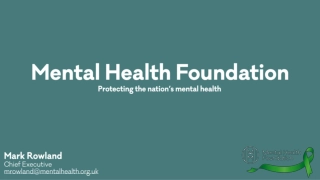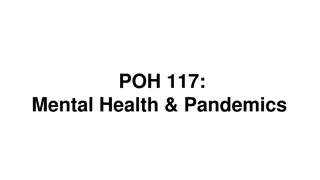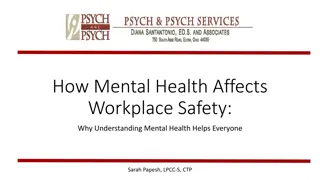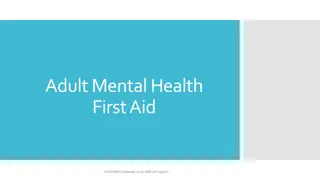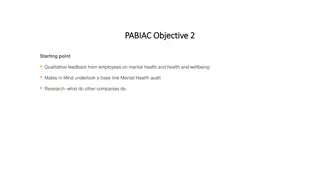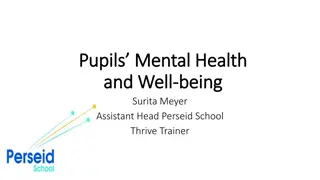Building a Positive Workplace for Employee Mental Health
Creating a positive workplace environment for employee mental health is essential. By implementing strategies and programs, addressing a range of problems, and promoting a supportive organizational climate, companies can reduce absenteeism, increase productivity, and enhance employee morale. Providing resources, clinical services, and work-based activities, along with incorporating mental health into general management practices, can contribute to a healthier and more engaged workforce.
Download Presentation

Please find below an Image/Link to download the presentation.
The content on the website is provided AS IS for your information and personal use only. It may not be sold, licensed, or shared on other websites without obtaining consent from the author.If you encounter any issues during the download, it is possible that the publisher has removed the file from their server.
You are allowed to download the files provided on this website for personal or commercial use, subject to the condition that they are used lawfully. All files are the property of their respective owners.
The content on the website is provided AS IS for your information and personal use only. It may not be sold, licensed, or shared on other websites without obtaining consent from the author.
E N D
Presentation Transcript
Creating a Positive Workplace for Employee Mental Health February 5, 2021 Patrick Tang, MPH Program Manager Ed Fisher, PhD Global Director
Access all recorded webinars and slides at Worksite Mental Health for Owners and Managers https://go.unc.edu/PROSPER 1. Strategies a. Range of Problems b. Range of Programs (Worksite Wellness/Health Promotion, Organizational Factors, Clinical Services) 2. Practicalities
STRATEGIES 3 www.peersforprogress.org
Problems and Objectives Types of problems Diagnoses e.g., Major Depressive Disorder (MDD), Generalized Anxiety Disorder (GAD) As per Diagnostic and Statistical Manual of the American Psychiatric Association (DSM-5) Broad range of problems hassles, feeling anxious or sad, family stressors, etc. Problems of the workplace stress, morale, cohesion, absenteeism Objectives Reduce absenteeism Increase presenteeism Increase morale, productivity, customer satisfaction Raise reputation of company as a good place to work and progressive, reliable source of products Reduce health care costs (mental health major driver itself and contributor to physical health problems)
Layers of Programs Policies and Practices HR Supervision and reporting relationships Organizational climate Objectives Reduce absenteeism Increase presenteeism Increase morale, productivity, customer satisfaction Raise reputation of company as a good place to work and progressive, reliable source of products Reduce health care costs (mental health major driver itself and contributor to physical health problems) Worksite Based Resources & Activities For Problems We all Have Workshops, Classes Group Programs Promotional Campaigns Clinical Services and Resources For diagnosed problems, those needing professional care EAP Adequate behavioral health coverage Family coverage (adolescent and spouse mental health often major driver of employer health costs)
Worksite as Community Range of Activities Wellness and peer support group and individual activities Incorporate mental health into general management practices, e.g., Quality Circles Company investment in resources: e.g., work-out room and equipment; nursing mothers facility; attractive, private room for group meetings; healthy vending machines and facilities for healthy diet refrigerators, stoves, microwaves Organization and Governance Employee engagement in program direction and implementation Employee steering committee workplace wide in small company, within units in larger When possible, choices by employees (e.g., purchases of break room equipment, topics for monthly wellness meetings) Advantage of Community Smoking Cessation in St. Louis Higher quit rates among those exposed to the broad campaign than among those who joined classes to help them quit (Fisher et al. Am J Health Promotion 1994 9: 39-47, 75.)
PRACTICALITIES 7 www.peersforprogress.org
Contracted vs Company Services Contracted Services Professional, services provided by organization focused on health/mental health Fixed costs Reduced management burden Confidentiality Company Based Services Direct management of nature, quality of services Reflect corporate culture Connect with worksite, employee-based activities and services Opportunity for leadership to set tone, example Link with broader organization initiatives re: morale, quality control, etc. Questions: To what extent is mental health, morale, etc. a core concern for business? (e.g., customer service vs. low tech manufacturing) Contract out for core business? Blending of types of services?
Wellness and Related Services Perspectives of Employees vs Management For management: stress management to teach employees skills that will increase productivity/decrease absenteeism For employees: stress management = fix my boss! Framing and Promotion Organize around common concerns, e.g., weight, exercise, feeling down, rather than clinical concerns, e.g., diabetes, depression. Provide company time for activities (assume gains in productivity will balance out lost time). Develop with employee input and employee exemplars in promotion. Critical roles of supervisors: endorsing vs grudging permission. Roles of managers: As participants? Setting tone. Clarifying commitment.
Peer Support Individual Support Great capacity e.g., successful cognitive behavior therapy for post-partum depression implemented by nonprofessional health workers in Pakistan Range of services: promote, navigate (e.g., insurance or available services), support health behavior change, implement health education Training: depending on services, 8 to 40 hours Need for coordination and back-up by HR or employee health staff Mutual Support Encourage all to support all, e.g., training on How to be a friend at work Train individuals to promote mutual support activities, pods Groups of coworkers focused on wide range of topics: exercise, shared interests, Moms Group or Cat Lovers Objective: everybody has someone at worksite with whom they can confide or call on for a favor What would achieving this do to corporate culture?
Example of Worksite Program: Stress Management Key Theme: Stress is what we do in dealing with stressors, not something that happens to us In Charge Session Topics Homework 1. Orientation: Stress is normal thing that we do Complete Daily Stress Inventory 2. Examine our stressors and how we react; Changing how we think Monitor how we think and alternative reactions 3. Changing global beliefs that drive how we think Monitor role of global beliefs in how we think 4. Combatting stress: Muscle relaxation intro and practice Practice muscle relaxation 5. Recurrent stressors: Assertiveness and problem solving Monitor recurrent stressors and antecedents and responses to them 6. Brainstorm application of assertion and problem solving Monitor assertion and problem solving and results 7. Making it mine: integrating how we talk, relaxation, assertion, problem solving Monitor personal plan for integrating how we talk, relaxation, assertion, problem solving 8. Summary and integration: What to watch for to keep it going Identify key challenges to watch for, how to address them Key to Behavior Change: Develop skills over time with homework leading to next session leading to homework .
Developing Health Promotion as Part of Worksite Community Begin with employees and their perceptions and needs Town hall meetings, surveys, web bulletin boards Employee steering committee look for decisions to turn over Consider placement outside of HR or health services, e.g., production manager as management lead Introduce company and management needs as part of the mix our ability to stay in business is threatened by health care costs Program emphases Traffic > content?? Promotion, events, contests Peer support and/or group programs Classes guided by steering committee Resources: walking path, cafeteria, exercise room, showers???????
ORGANIZATIONAL FACTORS 13 www.peersforprogress.org
Organizational Risk Factors Poor organization of work plays a significant role in development of mental health problems Content of work Workload Participation and control Job content Context of work Role in organization Reward Equity Interpersonal relationships Working environment Workplace culture Home-work interface
Content of Work Excessive workload Insufficient work Workload Inability to participate in decision-making Inability to choose how to complete work Lack of participation and control Monotonous tasks Unpleasant tasks Aversive tasks Killer combination: High demand with low control Job content World Health Organization. Mental Health Policies and Programmes in the Workplace.
Context of Work Role conflict Role ambiguity Role in organization Lack of recognition of work (e.g., through salary) Low status Inadequate social support in the workplace Lack of reward (recognition) Perception that workplace is not just or equitable(e.g., in terms of workload, salary, or promotion) Poor management of organizational change (e.g., downsizing) Inequity (lack of fairness) Unsupportive supervision Poor relationships with colleagues Bullying, harassment or violence Isolated or solitary work Poor interpersonal relationships Inadequate physical environment (e.g., noise, pollution, light, danger) Irregular working hours (e.g., shift work or excessive working hours) Working environment and conditions Poor communication Poor leadership Lack of clarity about workplace objectives and structure Workplace culture Conflicting demands at home and at work Lack of support for home at work Lack of support for work at home Home work interface
Strategies as Part of Overall Mental Health Policy Increase awareness of mental health issues Support employees at risk Provide treatment for employees with a problem Changing the organization of work Reintegrating employees with a problem into the workplace World Health Organization. Mental Health Policies and Programmes in the Workplace.
Beneficial Policies Encourage employees to use their vacation days Send employees home when they are sick Use lunchtime for social activities or walking with colleagues Map out a walking route for employees to help them get started Allow employees to take 15-minute power naps during the workday NB: U.S. needs to reverse view of sleep as weakness Sleep deprivation = inebriation Implications for bottom line?? Set the expectation that people don t respond to emails over night or over the weekends Normalize talking about stress and other mental health problems
Beneficial Policies, cont. Create quiet spaces for relaxation Train managers to recognize signs and symptoms of mental health problems among team members Team-building with physical activities (like walk-a-thons) Meaningful retreats (initiate dialogues around workplace values, culture, and mental health) Clear leadership support for EAP and confidentiality around it
Involve Employees Solicit feedback and ideas from employees on: Things that stress them out at the workplace Things that they love about the workplace What changes would make them feel happier in the workplace? Do they have positive experiences from other companies that might be adopted? Create a workplace wellness committee
Ways in which employees want their employers to keep them safe during COVID 1. Provide personal protective equipment 2. Provide assurances that employees will be notified if a colleague gets sick 3. Require customers to follow prescribed safety and personal hygiene practices 4. Provide assurances on cleanliness and disinfecting practices 5. Provide a clear response and shut-down protocols if someone tests positive 6. Promote and enforce social distancing 7. Require mandatory testing for employees returning to work after being out sick with COVID 8. Provide a method for employees to give feedback on COVID-19 policies and practices PwC Survey
Professional or Clinical Services Clinical Services & Resources Human Relations Employee Assistance Programs (EAP) Employee health insurance coverage for behavioral health Contract for services from behavioral health provider organization Identify services from County Health Departments Many emphasize mental health and substance use Community Mental Health Centers?? Primary Care Providers National Alliance on Mental Illness / North Carolina: https://naminc.org/
Worksite Health Promotion Resources Working Well Toolkit http://workplacementalhealth.org/Employer-Resources/The-Working-Well-Toolkit
Mental Health Resources Library of mental health resources for peers, staff and all employees at: https://go.unc.edu/mhr 11 Modules as Handouts or as PowerPoints for Webinars: 1. Sleep Disturbance Getting Good Sleep 2. Low Mood #1 Medications and Changing Assumptions 3. Low Mood #2 Problem Solving and Getting & Giving Social Support 4. Getting Back in the Game Resuming or Increasing Activities that Give Us Pleasure 5. Misuse of Food and Substances Problem Solving and Coping with Temptations 6. Anxiety Types and Ways to Manage 7. Post-Traumatic Stress Disorder (PTSD) 8. Problem Solving Psychological Aspirin 9. Social Skills / Family and Relationship Skills Skills for Everyday Problems 10. Social Support Getting and Giving 11. Changing Assumptions (Cognitive Therapy)
SUMMARY 25 www.peersforprogress.org
General: Recognize many choices in developing worksite mental health and that decisions should reflect organizational mission and objectives, nature of business, general role of work force in organizational objectives, nature of workforce, size and culture of organization, etc. Resources of NC Occupational Safety and Health Education and Research Center, and of Peers for Progress Expertise in worksite health promotion and peer support Consultation in program planning, development, implementation, evaluation Assistance in program implementation and training
Access all recorded webinars and slides at https://go.unc.edu/PROSPER



